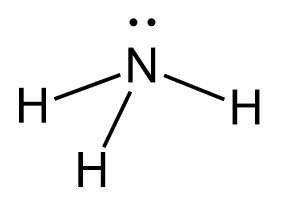To determine if NH3 is polar or nonpolar, we need to first determine its geometry. This presumes knowing the rules for drawing a correct Lewis structure and you can find more details about Lewis structures here.
Nitrogen is the central atom and there are a total of 5 + 3 = 8 valence electrons. We use six of them to make the three N-H bonds, and the remaining two go on the nitrogen as a lone pair:

The steric number of nitrogen is four (3 bond + 1 lone pair), and therefore, the electron geometry of ammonia, NH3 is tetrahedral while the molecular geometry is trigonal pyramidal:

Now, the polarity: The first thing here is to determine if the N-H bond is polar. Depending on the difference in the electronegativity values, covalent bonds can be polar and nonpolar.

- If the difference in electronegativity is less than 0.5, the electrons are about equally shared between the two atoms, forming a nonpolar a covalent bond.
- If the difference in electronegativity is between 0.5 and 1.7, we have a polar covalent bond.
- A difference of 1.7 or higher is so large that the electrons are no longer shared, and an ionic bond is formed. Ionic bonds are formed between metals and nonmetals.
The N-H bond is polar, and the unsymmetrical shape of the molecule results in an asymmetrical distribution of bonding electrons in the molecule. The overall permanent dipole is directed toward the N-H bonds as drawn below:

To summarize, ammonia is a polar molecule because its electron geometry is trigonal pyramidal and the dipoles of N-H bonds do not cancel out.
Remember, the net dipole of the molecule is the vector sum of all the dipoles and here it equals zero because the bonds are equivalent and pointing in opposite directions.
Check this 99-question multiple-choice quiz on Geometry and Hybridization:
Geometry and Hybridization Quiz
Check Also
- The VSEPR Model
- VSEPR Theory Practice Problems
- Hybridization of Atomic Orbitals
- sp, sp2, sp3, sp3d, and sp3d2 Hybridization Practice Problems

